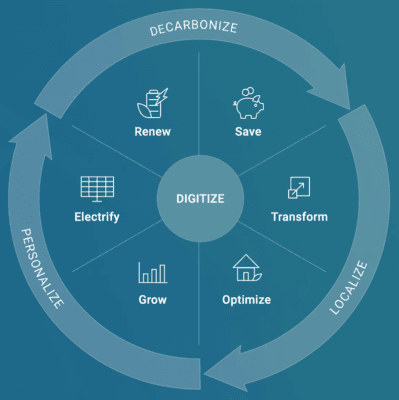Microgrids Power the Renewables Revolution

What would it take to minimize the use of carbon-based energy and maximize renewables across an entire community? You might start with microgrid technology. And that’s what one Caribbean island did—with beneficial results across a spectrum of metrics.
Recognizing the need to generate electricity from renewable sources instead of fossil fuels, the island’s owners and power system operator implemented an astounding transition: moving the island from 100 percent diesel power to greater than 90 percent renewables with microgrid technology. Its hybrid wind- and solar-powered electricity has radically improved sustainability, cost, and overall reliability.
Microgrids offer the possibility to accelerate the conversion to renewable energy by letting users mix and match distributed resources like wind, solar, storage, and hydropowered technologies.
The conversion didn’t come without challenges. For one, integrating different energy technologies and equipment can be complex and costly because they are not designed to work together. For example, something as “simple” as adding a battery to a photovoltaic (PV) system requires sophisticated control algorithms typically implemented by a PLC programmer or SCADA developer to custom-engineer the overall solution.
The project required the integration of incompatible equipment from numerous manufacturers, such as wind turbines from one supplier and dozens of inverters from another. But it overcame these challenges with help from Spirae, LLC—a company that develops solutions for integrating renewable and distributed energy resources within microgrids and power systems—and its WAVE Microgrid Control Software.
“What we do is make microgrids plug and play from an equipment perspective, so you can use any manufacturer’s equipment,” says Sunil Cherian, founder and CEO of Spirae. “Our mantra is localize, personalize, and decarbonize. This means configuring and operating local equipment to maximize renewable energy via digitization.”
By standardizing and streamlining the configuration, deployment, and operation of microgrids, the company’s Wave solutions bring distributed energy benefits within reach for most energy consumers (Figure 1).

Microgrid technology helped one community transition from 100 percent diesel power to more than 90 percent renewables.
Flexible Options Energize Smart Cities
The WAVE platform enables providers to customize applications specifically for the needs of different markets—such as utilities, communities, DER manufacturers, facility managers, residential, and others. Energy customers can evaluate equipment options and estimate returns on their investments by simulating and analyzing potential projects before proceeding.
Cities and municipalities can deploy a distributed energy system with a plug-and-play solution that enables them to:
- Offer a range of energy services to residents and businesses aligned with their energy policies.
- Offer standardized microgrid solutions that most closely matches the specific needs of energy consumers—including buildings, campuses, communities, and industrial applications.
- Leverage a configurable and expandable library of microgrid types, DER Assets, use cases, and value propositions.
- Manage microgrid deployments from concept to operations across a common platform.
- Automatically calculate metrics and generate reports for end-user and community stakeholders.
Powering an Industry With the IIoT
Spirae incorporated lessons learned from deploying a wide variety of microgrids into standard templates for use with other energy customers. “Microgrids can be deployed for a whole range of applications using almost any distributed energy resource,” Cherian says. “That brings a tremendous amount of flexibility to energy consumers.”
Because renewables can displace fuel cost over the life of a project, municipalities can achieve carbon-neutral power generation and lower costs at the same time. But this requires intelligent software to handle the management of those renewables and eliminate the challenges of interoperability, variability, and intermittency.
“A field-proven control system like Wave will solve the typical problems that people are concerned about,” states Cherian. “Power flow fluctuations due to renewables and EV charging need not be exported to the grid if you have the right systems in place.”
Of course, running these microgrid applications at the edge requires high-performance computing. Spirae relies on Intel® technology to power the on-premises IoT gateways and back-end infrastructure. The gateways that run on-premises control software interact with the cloud-hosted WAVE platform, which runs on Intel-based server-class systems. And Spirae can scale up its microgrid solutions via a virtualized compute environment.
“Intel in particular offers solutions that make it much easier to manage this type of edge-to-cloud infrastructure,” says Cherian. “These are the touchpoints for us—where its products and solutions really come into play in a big way for rolling out distributed energy solutions.”
In the end, microgrids bring energy closer to the consumer, whether it’s solar on the rooftop, energy storage systems in a house, or an electric vehicle with a smart charger. These types of systems are becoming more pervasive and less expensive. The options are substantially increasing.
“We believe microgrids are a complete game changer,” says Cherian. “You can deploy this technology anywhere in the world for a whole range of applications. It allows clean-energy solutions to be tailored to meet any energy consumer’s needs.”